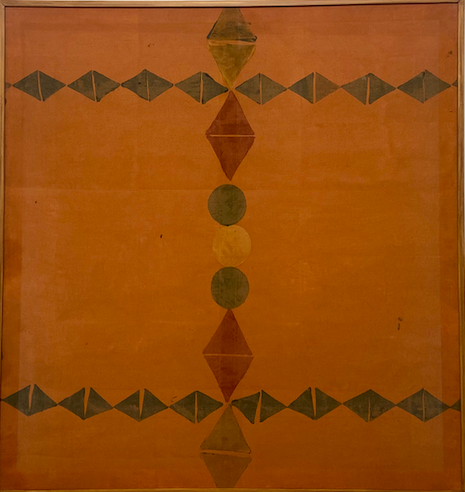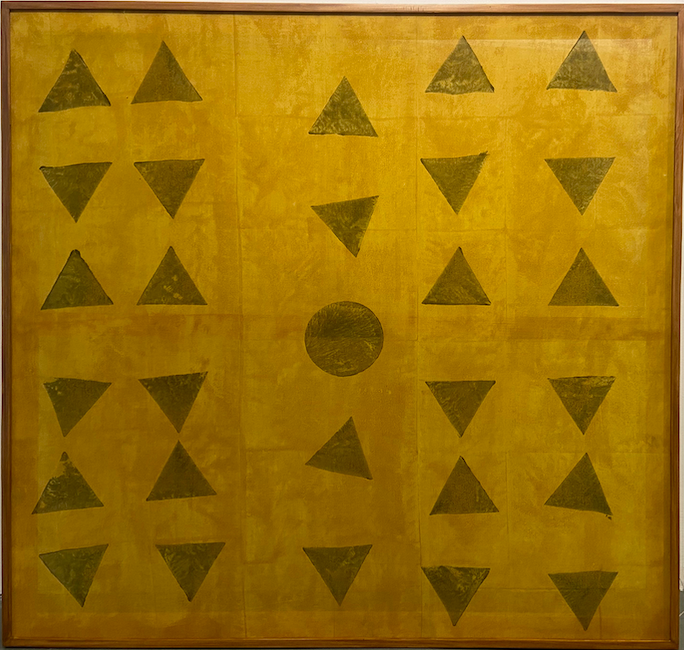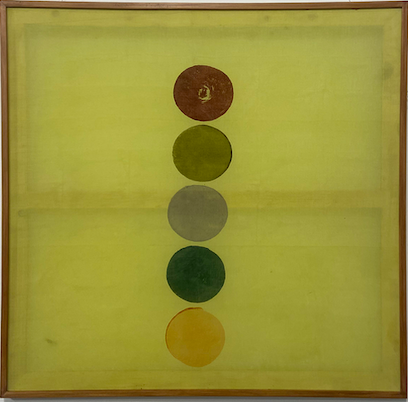Ether | The Fifth Element
These collection of textiles by Sayali Goyal is a contemporary, abstract interpretation of the five elements – Earth, Water, Fire, Air, and Ether that are often venerated for sacred meanings embedded in them. They are believed to form the basis of human life and the cosmos while also serving as a bridge between the worldly and divine realms. Across complex metabolic processes in an organism’s body, the changing of seasons, agriculture, food, religion, and some other walks of life, they work together in harmony to define our everyday lives.
This collection acknowledges how, in an ever-changing world, the fusion and balance amongst these four have been central to creation and existence. Human creativity and design decisions too, are consciously rooted in harmony and thus, adopt the characteristics of nature – a timeless connection between the intangible and the tangible that the artist attempts to imbibe in her practice. The union of the five elements has remained perpetually symbolic of certain highly valued aspects of human consciousness like wealth, beauty, abundance, sacrifice, worship, wisdom, fertility, and good health. Rituals and religious practices seeking and celebrating these are known to be part of our cultures and have infused our lives with warmth, colour, and hope.
The artist’s exploration of form, materials, textures, and aesthetics is thus, an attempt towards blurring the boundaries between the real and the abstract. The elements’ profound presence across different religious philosophies as metaphors, archetypes, and organizational principles shows how societies have valued them distinctly over time. Knowledge – in iconographic, oral, and written forms has found its way from ancient scriptures into art, architecture, design, rituals, medicinal and life sciences across geographies and time.
Design Manifestations
In Vastu Shastra, an ancient Hindu building science, recommendations for designing layouts of houses, and temples and placing special elements like water bodies and plants, are based on combining the energies of the five elements and the cardinal directions to invite prosperity. In the Western Asian region, the Persian ‘Chahar Bagh’ Gardens - an important part of the Iranian landscape are well-known for design principles like harmony, emphasis, balance, unity, and symmetry seen in their four-quadrant layout. These designs went on to be replicated in Persian carpets, potteries, and some forms of visual arts and are believed to have been derived from the Zoroastrian division of the universe into four parts/seasons/elements; water, wind, soil, and fire. Believed to evoke the image of paradise on Earth (as described in the Holy Quran), these gardens comprise neat plantations, terraces, shaded environments, chirping of birds, and sounds of flowing water that provide mental comfort and soothe the senses. The presence of pools, and fountains, along with perpendicular water channels highlights the integration of decorative and functional characteristics of water and its ability to create a pleasant experience and enhance the overall quality of life in dry regions. Emphasis on geometrical patterns, along with vibrant hues and fragrances of flowers is also seen in some Mughal gardens in India.
Five-tiered steles or tombs (Gorintos) discovered in Japan that look like towers are also representative of the five elements (Godai): earth, water, fire, wind, and space (also believed by the Buddhists to be the basis of the universe). Each element emerges out of the one below it, with earth being the heaviest and space being the lightest. Existing both in large and miniature forms, these stupa/pagoda-like monuments are often made of curved stone and used as grave markers, funerary monuments, and reliquaries. The bottom stone is a cube (Earth ring), the second, a sphere (Water ring), and above that a triangular shape like a pyramid (Fire ring), semi-sphere, (Wind ring) and located on the top is a peach-shaped hoju and is called Sky ring. A Sanskrit symbol is frequently seen on each stone.
The concept above has some semblance to the one proposed by the Greek philosopher Aristotle, who along with his followers believed that all substances are composed of these four elemental states of matter – a fact often usually mentioned in the history of chemistry books. Another intriguing Greek reference is that of the ‘Platonic Solids’ that are often seen in crystals, skeletons of microscopic sea animals, children’s toys, and art. They have been the subjects of study for many explorers like Plato, Euclid, and Kepler while commanding a good interest in classical as well as modern geometry. The solids are related to the five elements. The tetrahedron was compared to fire since its sharp stabbing points and edges reminded Plato of the piercing heat from flames. The octahedron was linked with air for its numerous small smooth parts make it seem as if it barely exists. The icosahedron was believed to be like water as it flows out of one’s hands. The cube was associated with the earth since it triggers dirt to crumble and fall apart, and also evokes the earth’s solidity. The dodecahedron was considered to include the whole universe and was used for arranging the constellations in the heavens.
The origin of the Four Element theory is often argued to be Persian and not Greek. The Persian prophet Zarathustra’s (converted by Greek writers to Zoroaster) concept of four elements has a perspective different and more sensible than the Aristotelian. According to him, air, water, earth, and fire are sacred elements. Humans and animals need air to breathe, water to drink, fire to cook food, and earth to grow plants for their survival and thus, earth, air, and water are to be kept free from defilement. According to Pagan beliefs, the five-pointed star or pentagram is an ancient symbol identifying the human (four limbs and the head) with the universe (five elements). When existing within a circle, it is referred to as a pentacle - often worn as a pendant or earrings or on a bracelet by Pagans to proclaim their identity.
Significance/essence of element
EARTH / It is the foundation of planetary life - the element that holds vast complementary value in relation to other elements. In Hinduism, the Vastupurashamandala (graphical manifestation of the plan of the cosmos) has as its basic form – a square (the ideal geometric shape in Hindu philosophy) that represents the earth. All other relevant forms like the triangle, hexagon, octagon, and circle can be derived from the square, whose sides represent the four cardinal directions. The square also symbolizes order and the totality of existence. Many Hindu religious and vernacular forms of architecture are known to have been based on the Vastupurashamandala - a medium to connect with the divine world.
WATER / Water denotes purity, nourishment, and fertility in many cultures. Water bodies like rivers, kunds, and stepwells are typically considered otherworldly and feminine according to ancient Indian scriptures. In addition to their utilitarian nature, and leading to great agricultural prosperity, they are endowed with deep religious and aesthetic meanings. It is often associated with the circle representing the universe and is considered an ideal shape, without any beginning and end - a sign of regeneration, timelessness, and infinity. In Persian gardens, water is the holiest of all elements - the symbolic significance of which, among Iranians was initiated before the Islamic period. Anahita, the goddess of Zoroastrians, is considered the goddess of all waters, who has the power to purify men and women and of giving life to the creatures of the world. Tistrya is also the god of rains and fertility, leading the Ahura Mazda armies. Muslims revere water as a crucial medium of cleaning and purifying. The Quran describes paradise as a garden beneath which rivers flow – the place where retaliation of good deeds, actions, and manners happens.
FIRE / A portal to reach out to the Supreme Creator according to ancient Hindu beliefs - fire reflects wisdom, passion & divinity. Its purifying qualities are believed to ward off evils and sorrows and induce stability, peace, and harmony. It symbolically manifests in the Shatkona, the six-pointed star with two interlocking triangles, wherein the upper one stands for Siva, Purusha & fire, and the lower one for Shakti, Prakriti & water. In Zoroastrianism, it is believed that there is one god ‘Ahura Mazda’ or the ‘Wise Spirit’ (contained by fire), and one evil (Ahriman). The effect of this dualistic conception of the universe is constant warfare going on between the two hostile camps to which all creatures belong. Fire, in the form of a burning candle, and water blessed by the Christian priest, are rituals in the church that can also be possibly traced back to Zoroaster’s days. Interestingly, in ancient times, while humans carried torches at night and gathered around campfires, communication, storytelling, and cultural exchange began to surface. The origin of the Olympic flame - lit and extinguished to mark the beginning and end of ceremonies, can be traced back to the sacred flame of Delphi. Extinguishing and lighting a fire signifies purification or regeneration. In Japanese mythology as well, the fire god represents calamity & protection.
AIR / Formless and invisible, it is a medium for other elements to take up another form. It is believed in Vastu Shastra that when in a balanced state, it induces courage and perseverance to achieve one’s goals and the placement of doors and windows for appropriate ventilation is determined by the direction associated with air.
ETHER / In Greek mythology, aether is the upper air that envelops the mountain peaks, moon, sun, and stars. It is breathed by gods, while mortals breathe normal air.





